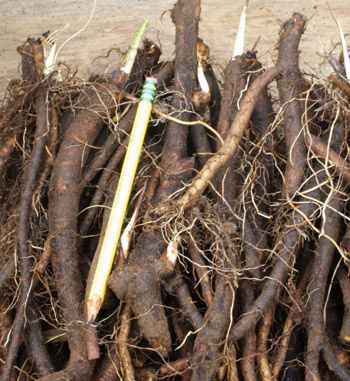[1] British Herbal Pharmacopoeia 1983 Published by the British Herbal Medicine
Association ISBN 0 903032 07 4.
[2] Herbal Materia Medica Course Notes For Diploma of Naturopathy and Diploma
of Herbalism Students by Lydia Mottram.
[3] Potter's New Cyclopaedia of Botanical Drugs and Preparations R.C.
Wren Revised by Elizabeth M. Williamson and Fred J Evans. First published in
Great Britain in 1988 and reprinted in 1989 and 1994 by the C. W. Daniel Company
Limited. 1 Church Path, Saffron Walden Essex. Published 1988 Printed and bound
by Biddles, Guildford ISBN 085207 1973.
[4] The Pharmaceutical Plant Company Pty Ltd
ppcherbs.com.au
Images
1.
commons.wikimedia.org
by
Matt Lavin from
Bozeman, Montana, USA Creative Commons Attribution-Share Alike 2.0 Generic
2.
strictlymedicinalseeds.com
3.
thegypsythread.org
Inner Path can not take any responsibility for any adverse effects from
the use of plants. Always seek advice from a professional before using a plant
medicinally.
Leaves and root
Allantoin.
[3,4] Pyrrolizidine alkaloids,
including echimidine, symphytine, lycopsamine, symlandine.
[5,6,7]
The alkaloids are found in the fresh young leaves and in the root, but in two
separate investigations were found to be absent in the dried herb
.[8,9]
S. tuberosum has a much lower akaloid content than the others.
[10]
Phenolic acids; rosmarinic, chlorogenic, caffeic, and lithospermic acids.
[11,12]
Mucilage, about 29%, composed of a poly saccharide containing glucose and fructose.
[13]
Choline, asparagine, volatile oil.
[14]
Triterpenes.
[15]
Leaves:
Pyrrolizidine Alkaloids; echimidine,
[1]
symphytine,
[1] lycopsamine, symlandine.
The alkaloids are found in fresh young leaves and in the root. In two separate
investigations were found to be absent in the dried herb. S. tuberosum has a much
lower alkaloid content then the others.
Allantoin.
[1]
Mucilage-
[1] about 30% composed of a
polysaccharide containing glucose and fructose.
Tannin.
[1,2] Choline. Asparagine.
Volatile oil. Triterpenes.
Root:
The cell proliferant- allantoin 0.6-0.8%.
[1]
Traces of alkaloids including pyrrolizidines.
Mucilage. Resin.
[1] Tannin.
[1]
Gum.
[1] Starch.
[1]
Sugars.
[1] Steroidal saponins (only
in the root).
[1,2,15]
PhD on symphytine pdf
Allantoin is probably responsible for its wound healing properties.
[16]
References
[1] British Herbal Pharmacopoeia 1983 Published by the British Herbal Medicine
Association ISBN 0 903032 07 4.
[2] Herbal Materia Medica Course Notes For Diploma of Naturopathy and Diploma
of Herbalism Students by Lydia Mottram.
[3] Martindale. The Extra Pharmacopoeia, 27th Ed. Pub. The Pharmaeutical Press
(1977) UK.
[4] Bhandari, P. and Gray, A. I. (1985) J. Pharm. Pharmacol. 37, 50P.
[5] Furuya, T. and Araki, K. (1968) Chem. Pharm. Bull. 16, 2512.
[6] Culvenor, C. J. J.
et al. (1980) Experientia 36, 377.
[7] Branchlij
et. al. (1982) Experientia 38, 1085.
[8] Monograph in The Irish Pharmacy Journal, May 1984, 171
[9] Roitman, J. N. (1981) Lancet i, 944.
[10] Gray, A. I.
et al. (1983) J. Pharm. Pharmocol. 35, 13P
[11] Gracza, L.
et. al. (1985) Arch. Pharm. 312 (12), 1090
[12] Kozhina, I. S.
et al. (1970) Rastit. Resur. 6, 345
[13] Franz, G. (1969) Planta Med. 17, 217
[14] Drogenkunde, 8th Ed. Heinz, A., Hoppe. Pub. W. de Gruyter (1975) Berlin
[15] Encyclopedia of Common Natural Ingredients used in Food Drugs and Cosmetics,
Albert Y, Lueng. Pub. John Wiley & Sons Inc (1980) NY
[16] Potter's New Cyclopaedia of Botanical Drugs and Preparations R.C.
Wren Revised by Elizabeth M. Williamson and Fred J Evans. First published in
Great Britain in 1988 and reprinted in 1989 and 1994 by the C. W. Daniel Company
Limited. 1 Church Path, Saffron Walden Essex. Published 1988 Printed and bound
by Biddles, Guildford ISBN 085207 1973.
[1] Potter's New Cyclopaedia of Botanical
Drugs and Preparations R.C. Wren Revised by Elizabeth M. Williamson and
Fred J Evans. First published in Great Britain in 1988 and reprinted in 1989
and 1994 by the C. W. Daniel Company Limited. 1 Church Path, Saffron Walden
Essex. Published 1988 Printed and bound by Biddles, Guildford ISBN 085207 1973.
[2] Gracza, L. et al. (1985) Arch. Pharm. 312 (12), 1090
[3] Mascolo, N. et al. (1987) Phytother. Res. 1 (1), 28
[4] Hirono, I. et al. (1979) J. Natl. Canc. Inst. 63 (2), 469
[5] Culvenor, C. J. J. et al. (1980) Experinetia 36, 377
[6] Schoental, R. et al. (1970) Cancer Res. 30, 2127
[7] Weston, C. F. M. et al. (1987) Brit. Med. J. 295, 183
[8] Branchlij et. al. (1982) Experientia 38, 1085.
[9] Monograph in The Irish Pharmacy Journal, may 1984, 171
[10] Roitman, J. N. (1981) Lancet i, 944
[11] Taylor, A. and Taylor, N. C. (1963) Proc. Soc. Exp. biol. Med. 114, 772
[12] White, R. D. et al. (1983) Toxicol Lett. 15, 25
 Symphytum
officinale. Comfrey,
Knitbone, Cosolida, Blackwort, Nipbone Family: Boraginaceae
Symphytum
officinale. Comfrey,
Knitbone, Cosolida, Blackwort, Nipbone Family: Boraginaceae
 PART
USED: Root- Collected
in Spring or Autumn.
PART
USED: Root- Collected
in Spring or Autumn.
